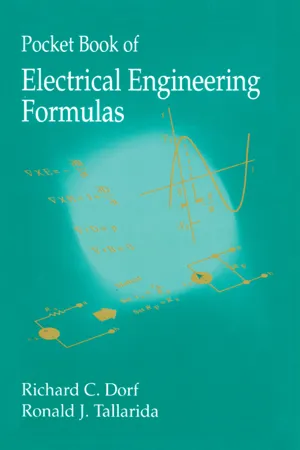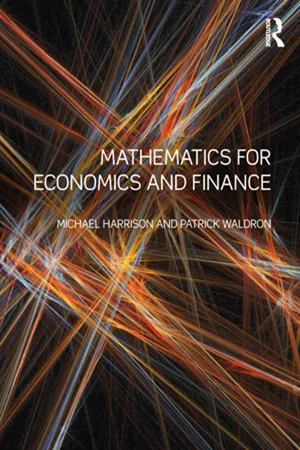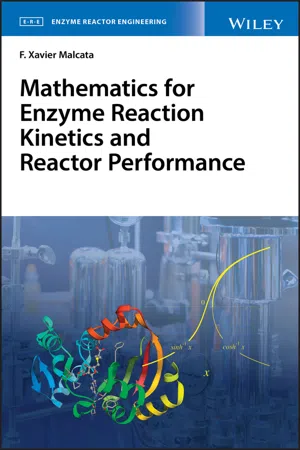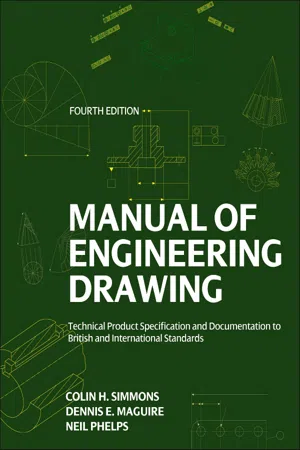Hyperbolas
A hyperbola is a type of conic section defined by the difference of the distances from any point on the curve to two fixed points called the foci. It has two separate and symmetrical branches that open in opposite directions. In mathematics, hyperbolas are important in the study of geometry, algebra, and calculus.
5 Key excerpts on "Hyperbolas"
- eBook - ePub
- Richard C. Dorf, Ronald J. Tallarida(Authors)
- 2018(Publication Date)
- CRC Press(Publisher)
...A circle at center O with radius c contains the vertices and illustrates the relation among a, b, and c. Asymptotes have slopes b / a and − b / a for the orientation shown. FIGURE 4.12. Hyperbola with center at (h, k): (x − h) 2 a 2 − (y − k) 2 b 2 = 1 ; slopes of asymptotes ± b / a. FIGURE 4.13. Hyperbola with center at (h, k): (y − k) 2 a 2 − (x − h) 2 b 2 = 1 ; slopes of asymptotes ± a / b. If the focal axis is parallel to the x-axis and center (h, k),. then (x − h) 2 a 2 − (y − k) 2 b 2 = 1 9. Change of Axes A change in the position of the coordinate axes will generally change the coordinates of the points in the plane. The equation of a particular curve will also generally change. • Translation When the new axes remain parallel to the original, the transformation is called a translation (Figure 4.14). The new axes, denoted x ′ and y ′ have origin 0′ at (h, k) with reference to the x and y axes. FIGURE 4.14. Translation of axes. FIGURE 4.15. Rotation of axes. A point P with coordinates (x, y) with respect to the original has coordinates (x ′, y ′) with respect to the new axes. These are related by x = x ′ + h y = y ′ + k For example, the ellipse of Figure 4.10 has the following simpler equation with respect to axes x ′ and y ′ with the center at (h, k): y ′ 2 a 2 + x ′ 2 b 2 = 1. • Rotation When the new axes are drawn through the same origin, remaining mutually perpendicular, but tilted with respect to the original, the transformation is one of rotation. For angle of rotation ϕ (Figure 4.15), the coordinates (x, y) and (x ′, y ′) of a point P are related by x = x ′ cos ϕ − y ′ sin ϕ y = x ′ sin ϕ + y ′ cos ϕ 10. General Equation of Degree Two A x 2 + B x y + C y 2 + D x + E y + F = 0 Every equation of the above form defines a conic section or one of the limiting forms of a conic. By rotating the axes through a particular angle ϕ, the xy -term vanishes, yielding A ′ x ′ 2 + C ′ y ′ 2 + D ′ x ′ + E ′ y ′ + F ′ = 0 with respect to the axes x ′ and y ′...
- eBook - ePub
- Michael Harrison, Patrick Waldron(Authors)
- 2011(Publication Date)
- Routledge(Publisher)
...However, a and b also come together, so that the equation of the ellipse converges to x 2 + y 2 = a 2 (4.17) which is the familiar equation of a circle of radius a centred at the origin. Thus the circle can be viewed as the conic section with eccentricity zero. We have seen that both hyperbola and ellipse collapse onto the horizontal axis as ϵ approaches unity; the parabola, which arises when ϵ = 1, is a singularity or discontinuity in this process. At the other extreme, as the eccentricity of a hyperbola tends to infinity, b also approaches infinity, and the term in y vanishes from the equation, leaving the pair of parallel vertical lines with equation x 2 = a 2 or x = ± a. The shape of a conic section also changes qualitatively as the focus parameter a approaches zero. The parabola collapses onto the positive x axis and the ellipse collapses onto the origin. The hyperbola, however, converges to the pair of lines that are its asymptotes. The details are left as Exercises 4.1 and 4.2. 4.2.5 General quadratic equation in two variables In the coordinate plane, the graph of a quadratic equation in two variables x and y is always a conic section, and all conic sections arise in this way. The equation will be of the form A x 2 + B x y + C y 2 + D x + E y + F = 0 (4.18) with A, B and C not all zero. The equation also relates to the concept of matrix quadratic form, introduced in the following section. 4.3 Quadratic forms Definition 4.3.1 A quadratic form in x n × 1 is a matrix product of the form x ┬ Ax, where x ≠ 0. Clearly A is of order n × n. Some texts require that A be symmetric, but this is not essential and sometimes using non-symmetric matrices is relevant. For present purposes, we also assume that A is a real symmetric matrix. It should also be noted that x ┬ Ax is a scalar. Example 4.3.1 Suppose x = [ x 1 x 2 ], A = [ a 11 a 12 a 21 a 22 ] and a 12 = a 21 by symmetry...
- F. Xavier Malcata(Author)
- 2020(Publication Date)
- Wiley(Publisher)
...If the (inclined) cutting plane is parallel to exactly one generating line of the cone, then the conic becomes unbounded and is termed parabola. In the remaining case, the outcome is a hyperbola – with the (inclined) plane intersecting both halves (or nappes) of the cone, and thus producing two separate unbounded curves. Both parabola and hyperbola are of a lesser practical interest, though – so they will not be further explored. Figure 13.4 Representation of circle and ellipse as contours of sectional surfaces of a cone, with a plane perpendicular or inclined, respectively, with regard to its axis of symmetry (‐ ‐ ‐). Remember that a circumference is the loci of points, P (x,y), on a plane equidistant from a given point, C, called center – with separation being denoted as (positive) radius R ; if such a point is, for simplicity, the origin of coordinates, i.e. (0,0), then the said condition is mathematically equivalent to (13.35) – or, based on the definition of distance as the length of the hypotenuse of a right triangle, with sides x and y as per Eq. (3.8), (13.36) where squares of both sides may be taken to yield (13.37) this curve is plotted in Fig. 13.5 a. Figure 13.5 Graphical representation of (a) a circumference of radius R, centered at C (0,0) with generic point P described by coordinates (x,y), and (b) an ellipse with generic point P (x,y), foci F 1 (−c, 0) and F 2 (c, 0), minor axis b equal to distance between C and either closest point, P eq, 1 or P eq, 2, and major axis a equal to distance between C and either farthest point, P md, 1 or P md, 2. An ellipse is the locus of points, P (x,y), on the plane such that the sum of their distances to two focal points, F 1 and F 2 – say, with coordinates (−c, 0) and...
- eBook - ePub
Manual of Engineering Drawing
Technical Product Specification and Documentation to British and International Standards
- Colin H. Simmons, Dennis E. Maguire(Authors)
- 2012(Publication Date)
- Butterworth-Heinemann(Publisher)
...Point A lies on the centre line in the plan view. 4. Take any horizontal section XX between A and B and draw a circle of diameter D in the plan view. 5. Project the line of section XX onto the end elevation. 6. Mark the chord-width W in the plan, on the end elevation. These points in the end elevation form part of the hyperbola. 7. Repeat with further horizontal sections between A and B, to complete the hyperbola. 8. The ellipse, parabola, and hyperbola are also the loci of points which move in fixed ratios from a line (the directrix) and a point (the focus). The ratio is known as the eccentricity. • The eccentricity for the ellipse is less than one. • The eccentricity for the parabola is one. • The eccentricity for the hyperbola is greater than one. FIGURE 14.4 Figure 14.5 shows an ellipse of eccentricity 3/5, a parabola of eccentricity 1, and a hyperbola of eccentricity 5/3. The distances from the focus are all radial, and the distances from the directrix are perpendicular, as shown by the illustration. To assist in the construction of the ellipse in Fig. 14.5, the following method may be used to ensure that the two dimensions from the focus and directrix are in the same ratio. Draw triangle PA1 so that side A1 and side P1 are in the ratio of 3–5 units. Extend both sides as shown. From any points B, C, D, etc., draw vertical lines to meet the horizontal at 2, 3, 4, etc.; by similar triangles, vertical lines and their corresponding horizontal lines will be in the same ratio. A similar construction for the hyperbola is shown in Fig. 14.6. FIGURE 14.5 FIGURE 14.6 (a) Ellipse construction. (b) Hyperbola construction. Commence the construction for the ellipse by drawing a line parallel to the directrix at a perpendicular distance of P3 (Fig. 14.6 (a)). Draw radius C3 from point F1 to intersect this line. The point of intersection lies on the ellipse. Similarly, for the hyperbola (Fig. 14.6 (b)) draw a line parallel to the directrix at a perpendicular distance of Q2...
- eBook - ePub
Manual of Engineering Drawing
British and International Standards
- Colin H. Simmons, Dennis E. Maguire, Neil Phelps(Authors)
- 2020(Publication Date)
- Butterworth-Heinemann(Publisher)
...The distances from the focus are all radial, and the distances from the directrix are perpendicular, as shown by the illustration. Fig. 14.6 (A) Ellipse construction. (B) Hyperbola construction. To assist in the construction of the ellipse in Fig. 14.5, the following method may be used to ensure that the two dimensions from the focus and directrix are in the same ratio. Draw triangle PA1 so that side A1 and side P1 are in the ratio of 3–5 units. Extend both sides as shown. From any points B, C, D, etc., draw vertical lines to meet the horizontal at 2, 3, 4, etc.; by similar triangles, vertical lines and their corresponding horizontal lines will be in the same ratio. A similar construction for the hyperbola is shown in Fig. 14.6. Commence the construction for the ellipse by drawing a line parallel to the directrix at a perpendicular distance of P3 (Fig. 14.6 (a)). Draw radius C3 from point F1 to intersect this line. The point of intersection lies on the ellipse. Similarly, for the hyperbola (Fig. 14.6 (b)) draw a line parallel to the directrix at a perpendicular distance of Q2. Draw radius S2, and the hyperbola passes through the point of intersection. No scale is required for the parabola, as the perpendicular distances and the radii are the same magnitude. Repeat the procedure in each case to obtain the required curves. Interpenetration Many objects are formed by a collection of geometrical shapes such as cubes, cones, spheres, cylinders, prisms, and pyramids., and where any two of these shapes meet, some sort of curve of intersection or interpenetration results. It is necessary to be able to draw these curves to complete drawings in orthographic projection or to draw patterns and developments. The following drawings show some of the most commonly found examples of interpenetration...




